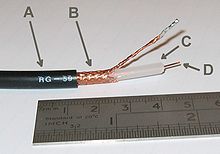This article needs additional citations for verification. (August 2016) |
RG-59/U is a specific type of coaxial cable, often used for low-power video and RF signal connections. The cable has a characteristic impedance of 75 ohms, and a capacitance of around 20pF/ft (60pF/m).[1] The 75 ohm impedance matches a dipole antenna in free space. RG (for radio guide) was originally a unit indicator for bulk radio frequency (RF) cable in the U.S. military's Joint Electronics Type Designation System. The suffix /U means for general utility use. The number 59 was assigned sequentially. The RG unit indicator is no longer part of the JETDS system (MIL-STD-196E) and cable sold today under the RG-59 label does not necessarily meet military specifications.

- Outer plastic sheath
- Copper braid shield
- Inner dielectric insulator
- Copper-plated core (sometimes solid core)
RG-59 is often used at baseband video frequencies, such as composite video. It may also be used for broadcast frequencies, but its high-frequency losses are too high to allow its use over long distances; in these applications, RG-6 or RG-11 are used instead. In cases where the transmission distance is too long for these media, such options as UTP (unshielded twisted pair) or fiber optic can be used.
RG-59 coaxial cable is commonly packed with consumer equipment, such as VCRs or digital cable/satellite receivers. Manufacturers tend to include only RG-59 cables because it costs less than RG-6 does. However, given the short lengths provided (usually 4–6 ft or 1.2–1.8 m), this is generally sufficient for its typical use.
RG-59 is frequently used to synchronize two digital audio devices, such as ADAT optical devices. This is called word clock.
See also
edit- BNC connector
- Coaxial cable
- RG-58 – A similar cable but with an impedance of 50 or 52 ohms
References
edit- ^ "Product Specifications : 8261303/10 & 5571 WHRL RG59 40 1000" (PDF). Objects.eanixter.com. Retrieved 2016-08-03.
Bibliography
edit- Straw, Dean. The ARRL Handbook for Radio Communications 2006 (83rd ed.). Newington, CT: American Radio Relay League. ISBN 0-87259-949-3. OCLC 62026192.